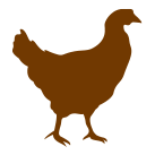Protein for Laying Hens
Pump up the protein for your hens this winter. Here’s why.

Protein is an important nutrient for hens and other poultry. It is needed for egg production, immunity, maintaining body weight, growing feathers and general body functions. Proteins that the hen consumes (including bugs, worms and insects) are made up of different types and amounts of amino acids and these amino acids are the building blocks for eggs, immune response, muscles, feather and bodily processes. There has been a lot of scientific research that goes into understanding how much of each amino acid, and by default, how much protein is required by a laying hen at each stage of her laying cycle. It is generally between 15% and 19% crude protein depending on the number of eggs being produced, age, feed intake and whether hens are moulting or not.
Layer feed is often made up of protein sources such as legumes, oil seed meal and animal by-products. Even grains such as wheat, barley and sorghum have between 8% to 14% of protein. However, while they make an ideal treat for hens, their sole diet shouldn’t be comprised of grain. Not only is the protein in grain too low to support the laying hen, the amino acid composition isn’t what the hen requires for good egg production and health. It is important to ensure that hens have access to a good quality feed that is made by a reputable supplier where the feeds have been carefully formulated to meet the nutrient requirements of the hen. In order to be a complete feed, layer pellets or mash should be formulated with a combination of grains and grain by-products, protein meals, fats and oils, minerals, vitamins and enzymes. This diverse range of ingredients should be formulated to supply all the important nutrients for egg production, egg quality and bird health and will keep your hen in the best possible condition.
As we are coming into autumn and winter, higher protein feeds become more important. This is the time of year where hens go into their yearly moult and also are working to stay warm during winter. A moult is a natural process where hens lose their feathers, reduce or stop laying and then regrow their feathers. Regrowing feathers requires a lot of protein and amino acids because feathers are between 80% and 85% protein. Therefore, extra protein in the diet of your hen helps her maintain her body weight through the moult and in winter. By not losing weight during the moult and in winter, the hen is better equipped to give you more eggs in spring.
If you are buying an end of lay hen from a commercial layer farmer and she is scruffy looking with lots of missing feathers, look to put her on a higher protein feed (16.5%+ protein). This will help increase or maintain her weight and support her as she grows back her feathers.
Whether you are getting point of lay pullets or end of lay hens from a commercial layer farmer, it is ideal to ask for a kilo of the feed that the pullet or hen is already eating. This will allow you to blend this current feed with the new feed that you are going to be feeding her over a few days and gradually transition the hens onto your new feed.

